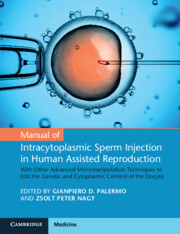 Manual of Intracytoplasmic Sperm Injection in Human Assisted Reproduction
Manual of Intracytoplasmic Sperm Injection in Human Assisted Reproduction Published online by Cambridge University Press: 02 December 2021
Application of intracytoplasmic morphologically selected sperm injection (IMSI) is a matter of debate; however, it is evident that deselection of spermatozoa presenting respectively spermatozoa with vacuole-like structures and asymmetrical insertion of the neck has multiple benefits. Defective sperm function and molecular defects contribute to early embryonic development disturbance, failure of blastocyst formation, miscarriages, and congenital birth defects. Introduction of IMSI has made embryologists aware that for ICSI the selection of sperm should be given proper attention. We have to consider IMSI has improved the ICSI technique. Compared to “blind” spermatozoa aspiration at low magnification and/or reduced optics contrast, observation under optimal contrast optics increases the probability of selecting a normal spermatozoa. This is particularly evident in cases of severe teratozoospermia, with low responder and advanced age women. Practicable and technical aspects of morphologically normal sperm selection must be considered to facilitate the workflow while performing IMSI and avoiding damage to the oocytes. A proper set up of the dish for selecting and capturing sperm facilitates routine application of IMSI.
To save this book to your Kindle, first ensure no-reply@cambridge.org is added to your Approved Personal Document E-mail List under your Personal Document Settings on the Manage Your Content and Devices page of your Amazon account. Then enter the ‘name’ part of your Kindle email address below. Find out more about saving to your Kindle.
Note you can select to save to either the @free.kindle.com or @kindle.com variations. ‘@free.kindle.com’ emails are free but can only be saved to your device when it is connected to wi-fi. ‘@kindle.com’ emails can be delivered even when you are not connected to wi-fi, but note that service fees apply.
Find out more about the Kindle Personal Document Service.
To save content items to your account, please confirm that you agree to abide by our usage policies. If this is the first time you use this feature, you will be asked to authorise Cambridge Core to connect with your account. Find out more about saving content to Dropbox.
To save content items to your account, please confirm that you agree to abide by our usage policies. If this is the first time you use this feature, you will be asked to authorise Cambridge Core to connect with your account. Find out more about saving content to Google Drive.